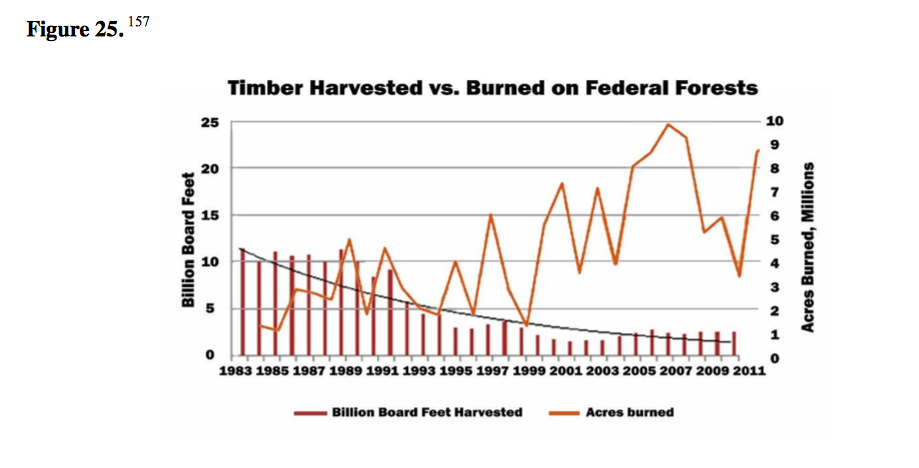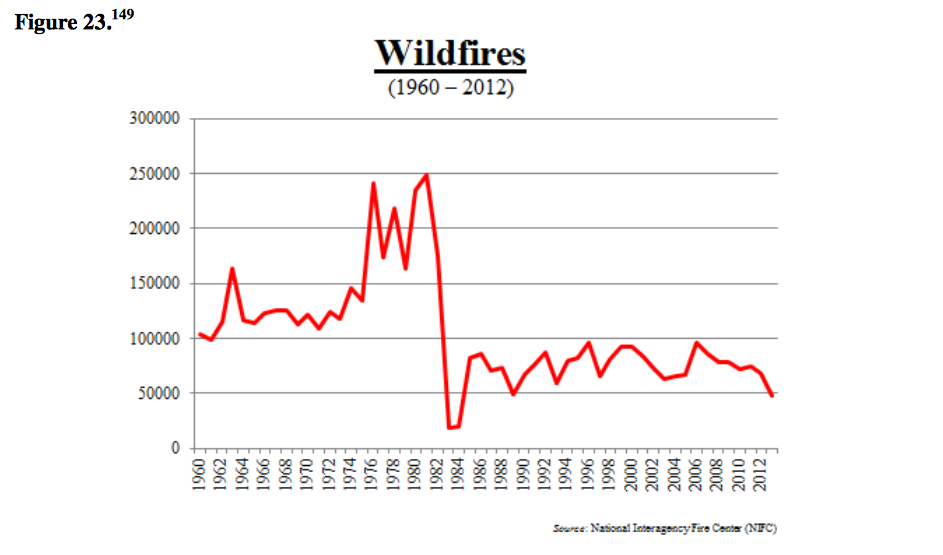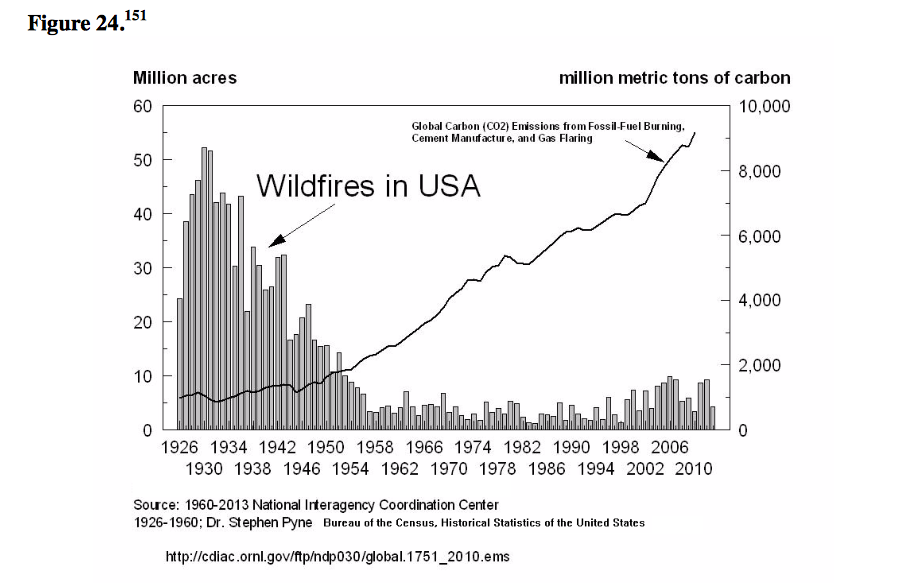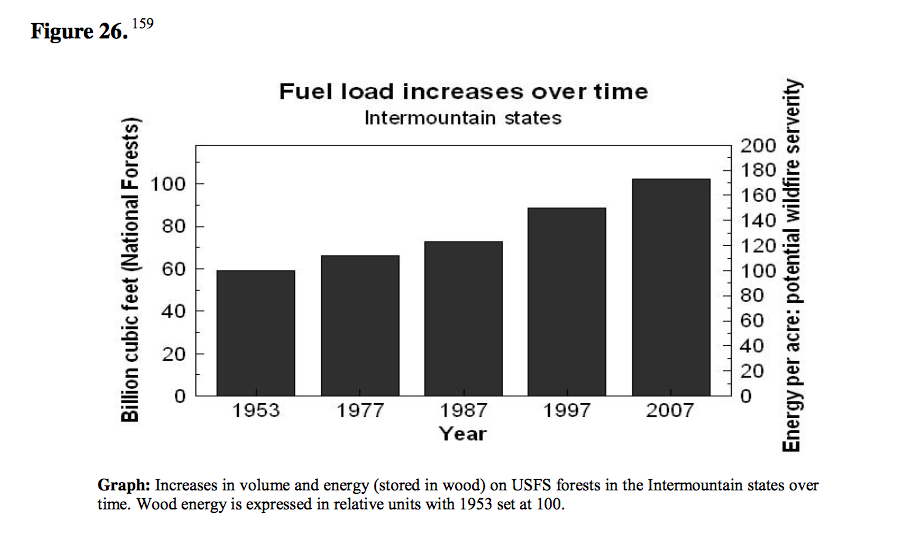False.
If forest fire damage has increased, it is most likely caused by changes in forest management/logging, recordkeeping and forest fire fighting. There is no way to scientifically attribute any change in forest fires to an increase in atmospheric CO2 of about 0.01%.
Check out the following from the Senate report “Critical Thinking on Climate: Empirical Evidence to Consider Before Taking Regulatory Action and Implementing Economic Policies (September 4, 2014).”




The media release for the bogus claim is below.
###
Climate change has doubled western US forest fires, says study
More aridity is sending thousands of square miles up in flames
THE EARTH INSTITUTE AT COLUMBIA UNIVERSITY
A new study says that human-induced climate change has doubled the area affected by forest fires in the U.S. West over the last 30 years. According to the study, since 1984 heightened temperatures and resulting aridity have caused fires to spread across an additional 16,000 square miles than they otherwise would have–an area larger than the states of Massachusetts and Connecticut combined. The authors warn that further warming will increase fire exponentially in coming decades. The study appears today in the journal Proceedings of the National Academy of Sciences.
“No matter how hard we try, the fires are going to keep getting bigger, and the reason is really clear,” said study coauthor Park Williams, a bioclimatologist at Columbia University’s Lamont-Doherty Earth Observatory. “Climate is really running the show in terms of what burns. We should be getting ready for bigger fire years than those familiar to previous generations.”
Fires in western forests began increasing abruptly in the 1980s, as measured by area burned, the number of large fires, and length of the fire season. The increases have continued, and recently scientists and public officials have in part blamed human-influenced climate change. The new study is perhaps the first to quantify that assertion. “A lot of people are throwing around the words climate change and fire–specifically, last year fire chiefs and the governor of California started calling this the ‘new normal,’ ” said lead author John Abatzoglou, a professor of geography at the University of Idaho. “We wanted to put some numbers on it.”
Warmth drives fire by drying out the land. Warmer air can hold more moisture, and the air ends up sucking it out of plants, trees, dead vegetation on the ground, and soil. Average temperatures in forested parts of the U.S. West have gone up about 2.5 degrees F since 1970, and are expected to keep rising. The resulting drying effect is evident in the rise of more fires. Williams published a study last year showing how climate-driven removal of moisture from land worsened the recent California drought, which was accompanied by widespread fires.
The overall increase in fire since the 1980s is about twice what the researchers attribute to climate change; the rest is due to other factors, they say. One has been a long-term natural climate oscillation over the Pacific Ocean that has steered storms away from the western United States. Another: firefighting itself. By constantly putting out fires, authorities have allowed areas they “saved” to build up more dry fuel, which later ignites, causing ever more catastrophic blazes, the researchers say. The costs of fire fighting have risen sharply in step; last year the federal government alone spent more than $2.1 billion. “We’re seeing the consequence of very successful fire suppression, except now it’s not that successful anymore,” said Abatzoglou.
The authors teased out the effects of climate warming from other factors by looking at eight different systems for rating forest aridity; these included the Palmer Drought Severity Index, the MacArthur Forest Fire Danger Index and the Canadian Forest Fire Danger Rating System. They then compared such measurements with observations of actual fires and large-scale climate models that estimate manmade warming. The crunched data showed that 55 percent of the increase in fuel aridity expected to lead to fires could be attributed to human-influenced climate change. Climate’s role in increasing such aridity has grown since 2000, the researchers say, and will continue to do so.
Williams and Abatzoglou say they do not account for some factors that could be offshoots of climate warming, and thus they may be understating the effect. These include millions of trees killed in recent years by beetles that prefer warmer weather, and declines in spring soil moisture brought on by earlier snowmelt. There is also evidence that lighting–the usual initial spark–may increase with warming.
The study does not cover western grasslands. These have seen more fires too, but there is little evidence that climate plays a role there, said Abatzoglou; rather, the spread of highly flammable invasive grasses appears to be the main driver.
Mike Flannigan, a fire researcher at the University of Alberta, said that previous studies have tried to understand the effects of climate on fires in parts of Canada, but that nothing had been done for the United States on this scale. “What’s great about this paper is that it quantifies this effect, and it does it on a national scale,” he said.
Worldwide, wildfires of all kinds have been increasing, often with a suspected climate connection. Many see a huge fire that leveled part of the northern city of Fort McMurray, Alberta, this May as the result of a warming trend that is drying out northern forests. Fires have even been spreading beyond, into the tundra, in places where blazes have not been seen for thousands of years. That said, fires are not expected to increase everywhere. “Increased fire in a lot of places agrees with the projections,” said Jeremy Littell, a research ecologist with the U.S. Geological Survey in Anchorage, Alaska. “But in many woodlands, the relationship between climate and fire is not as tidy.”
So far, this year has seen huge, though not record, fires. Over the summer, some 3 million acres burned across the United States, mostly in the West, from Washington state across to the Dakotas and down into Texas. Some scientists say the worst could be yet to come; in some places, the most dangerous conditions often occur from September to December, when desert winds interact with fuels that have been drying for five or six months.
The effects go beyond loss of trees and other vegetation. A 2012 study estimates that smoke from fires worldwide causes long-term health effects that kill some 340,000 people each year, mainly in sub-Saharan Africa and southeast Asia. Carbon released to the air adds to the burden of greenhouse gases already there, thus producing even more warming. Soot settling on snow and ice causes them to absorb more heat and melt faster.
Many scientists studying the issue believe the growth in U.S. western fires will continue for many years. Williams and others say that eventually, so many western forests will burn, they will become too fragmented for fires to spread easily, and the growth in fire will cease. But, he says, “there’s no hint we’re even getting close to that yet. I’d expect increases to proceed exponentially for at least the next few decades.” In the meantime, he said, “It means getting out of fire’s way. I’d definitely be worried about living in a forested area with only one road in and one road out.”
###
Junk Science editors—I like the way you refute the allegations with factual graphs of the actual data—blows them out of the water. As Pres. Adams said—“facts are stubborn things”!
Record keeping. What qualifies as a wildfire to be reported to the NIFC? One-tenth (.1) acre, or an area 50 feet X 100 feet. In 2015, the State of Connecticut reported a grand total of 76 wildfires from all reporting federal and state agencies. Those 76 fires burned 159 acres. Some states now report fires handled by county and local fire departments (C&L). For example, in 2015 Nevada reported 34 C&L fires that burned 156 acres. Did some children in your area start a fire in a vacant lot with fireworks last Independence Day? If so, chances are it was counted as a “wildfire.”
A slight increase in western state wildfire totals in recent years comes from no longer counting “use fires” separately. (A use fire was a naturally occurring fire, such as one started by lightning, that is allowed to burn.)
Notice how its always “a study”
What is a study really? Im not aware of any science done by study.
Studies are symptomatic of social science or medicine.
Wow , doubled the amount of fires. That could mean from 1 to 2.
Headlines like that make me doubt anything said.